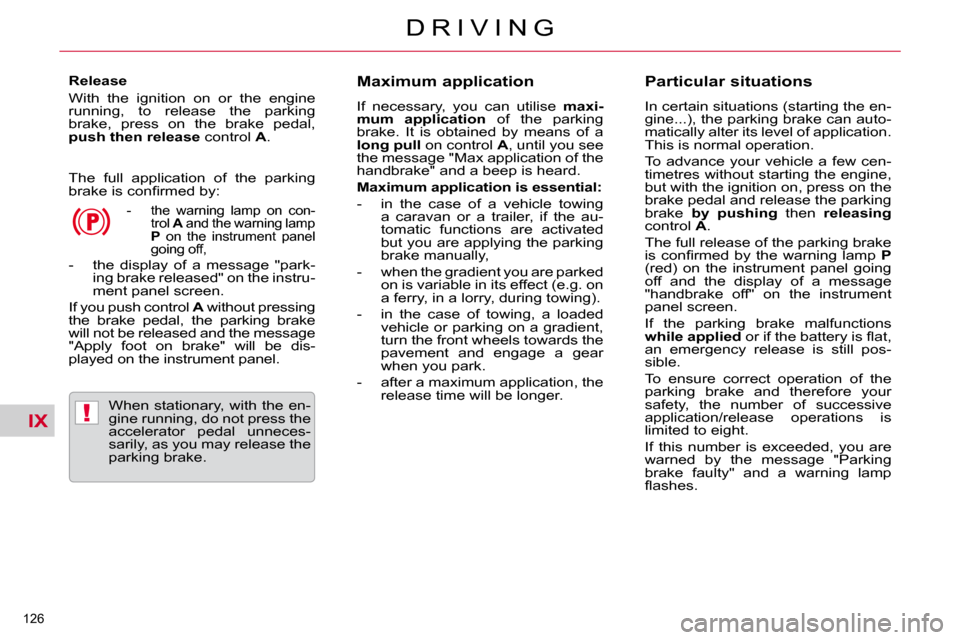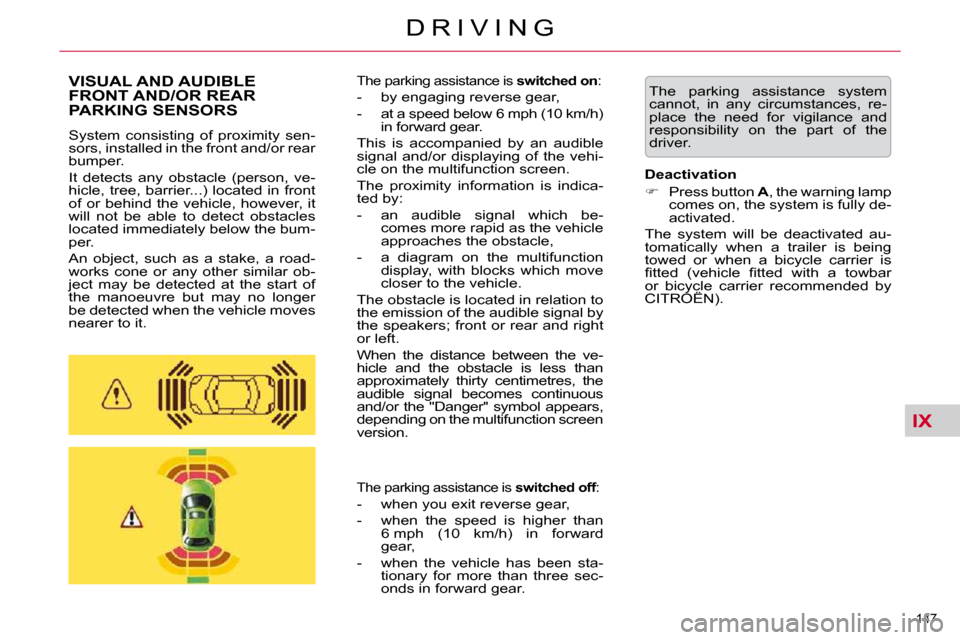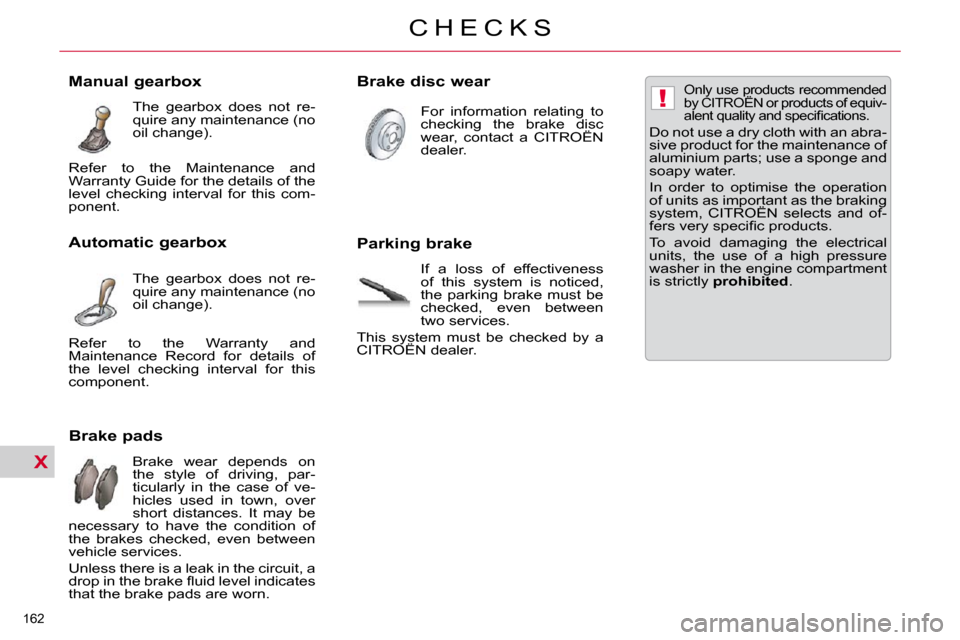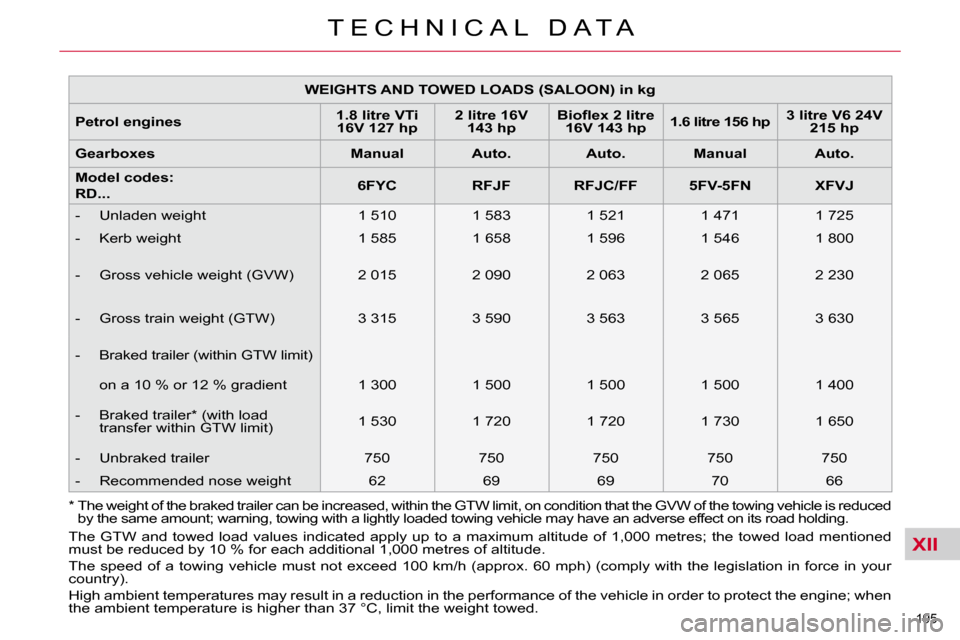tow Citroen C5 DAG 2009.5 (RD/TD) / 2.G User Guide
[x] Cancel search | Manufacturer: CITROEN, Model Year: 2009.5, Model line: C5 DAG, Model: Citroen C5 DAG 2009.5 (RD/TD) / 2.GPages: 306, PDF Size: 18.91 MB
Page 128 of 306

IX!
126
D R I V I N G
Release
With the ignition on or the engine
running, to release the parking
brake, press on the brake pedal,
push then release control A .
The full application of the parking
�b�r�a�k�e� �i�s� �c�o�n�fi� �r�m�e�d� �b�y�:�
- the warning lamp on con- trol A and the warning lamp
P on the instrument panel
going off,
- the display of a message "park- ing brake released" on the instru-
ment panel screen.
If you push control A without pressing
the brake pedal, the parking brake
will not be released and the message
"Apply foot on brake" will be dis-
played on the instrument panel.
When stationary, with the en-
gine running, do not press the
accelerator pedal unneces-
sarily, as you may release the
parking brake. Maximum application
If necessary, you can utilise
maxi-
mum application of the parking
brake. It is obtained by means of a
long pull on control A , until you see
the message "Max application of the
handbrake" and a beep is heard.
Maximum application is essential:
- in the case of a vehicle towing a caravan or a trailer, if the au-
tomatic functions are activated
but you are applying the parking
brake manually,
- when the gradient you are parked on is variable in its effect (e.g. on
a ferry, in a lorry, during towing).
- in the case of towing, a loaded vehicle or parking on a gradient,
turn the front wheels towards the
pavement and engage a gear
when you park.
- after a maximum application, the release time will be longer. Particular situations
In certain situations (starting the en-
gine...), the parking brake can auto-
matically alter its level of application.
This is normal operation.
To advance your vehicle a few cen-
timetres without starting the engine,
but with the ignition on, press on the
brake pedal and release the parking
brake
by pushing then releasing
control A .
The full release of the parking brake
�i�s� �c�o�n�fi� �r�m�e�d� �b�y� �t�h�e� �w�a�r�n�i�n�g� �l�a�m�p� � P
(red) on the instrument panel going
off and the display of a message
"handbrake off" on the instrument
panel screen.
If the parking brake malfunctions
while applied � �o�r� �i�f� �t�h�e� �b�a�t�t�e�r�y� �i�s� �fl� �a�t�,�
an emergency release is still pos-
sible.
To ensure correct operation of the
parking brake and therefore your
safety, the number of successive
application/release operations is
limited to eight.
If this number is exceeded, you are
warned by the message "Parking
brake faulty" and a warning lamp
�fl� �a�s�h�e�s�.� �
Page 137 of 306

IX
!
135
D R I V I N G
Never select positions P or R
if the vehicle is not stationary.
If, while the vehicle is moving, po-
sition N is engaged inadvertently,
allow the engine to idle before en-
gaging position D or M .
Moving off
� To start the engine, the gear le-
ver must be in position P or N .
� Operate the starter.
� When the engine is running,
place the gear lever on R , D or
M as required.
� Check, in the instrument panel,
the position engaged.
� Release the brake pedal and ac-
celerate.
� To avoid incoherence between
the position of the gear lever and
the actual position of the gear-
box, always exit from position
P with the ignition on and brake
pedal applied.
Otherwise, when the ignition is on or
the engine is running:
� reposition the gear lever in posi-
tion P ,
� put your foot on the brake ped-
al and then select the gear you
want. Park
This position of the gear le-
ver is used to prevent the
vehicle from moving when
you are stationary.
� To select position P, move the
gear lever back to the highest
position (towards R ), then push
it forwards and then to the left.
� To exit position P , move the gear
lever to the right and then to the
position you want.
� Only engage this position when
the vehicle is completely sta-
tionary. In this position, the front
wheels are locked. Make sure
that the gear lever is correctly
positioned. Reverse gear
Only engage this position
when the vehicle is station-
ary. To prevent snatching,
do not accelerate too soon
after selection.
Neutral Never select position N if
the vehicle is moving.
Page 138 of 306

IX
136
D R I V I N G
Automatic operation
� Move the gear lever to position D .
The gearbox constantly selects the gear that is best suited to the
following parameters:
- driving style,
� � �-� � �r�o�a�d� �p�r�o�fi� �l�e�
- vehicle load.
The gearbox operates without requir-
ing any intervention on your part.
For certain manoeuvres (for ex-
ample overtaking), you can obtain
maximum acceleration by pressing
the accelerator pedal hard down
past the point of resistance, which
then produces an automatic change
down to a lower gear. When braking, the gearbox may
change down automatically in order
to provide effective engine braking.
If you lift your foot off the accelera-
tor abruptly, the gearbox will not en-
gage a higher gear.
Manual operation
Position of the gear lever for manual
gear changing.
� Move the gear lever to position M .
� Push the gear lever towards the
" + " sign to change up a gear.
� Pull the gear lever towards the
" - " sign to change down a gear. - If the vehicle stops or reduces
speed (for example when ap-
proaching a stop sign), the gear-
box changes down automatically
�t�o� �fi� �r�s�t� �g�e�a�r�.�
- In sequential mode, it is not nec- essary to release the accelerator
during gear changes.
- A request to change gear is ac- cepted only if the engine speed
permits it.
- The SPORT and SNOW modes
do not operate in sequential
mode.
Page 149 of 306

IX
147
D R I V I N G The parking assistance system
cannot, in any circumstances, re-
place the need for vigilance and
responsibility on the part of the
driver.
VISUAL AND AUDIBLE FRONT AND/OR REAR PARKING SENSORS
� �S�y�s�t�e�m� �c�o�n�s�i�s�t�i�n�g� �o�f� �p�r�o�x�i�m�i�t�y� �s�e�n�-
sors, installed in the front and/or rear
bumper.
It detects any obstacle (person, ve-
hicle, tree, barrier...) located in front
of or behind the vehicle, however, it
will not be able to detect obstacles
located immediately below the bum-
per.
An object, such as a stake, a road-
works cone or any other similar ob-
ject may be detected at the start of
the manoeuvre but may no longer
be detected when the vehicle moves
nearer to it.
The parking assistance is
switched on :
- by engaging reverse gear,
- at a speed below 6 mph (10 km/h)
in forward gear.
This is accompanied by an audible
signal and/or displaying of the vehi-
cle on the multifunction screen.
The proximity information is indica-
ted by:
- an audible signal which be- comes more rapid as the vehicle
approaches the obstacle,
- a diagram on the multifunction display, with blocks which move
closer to the vehicle.
The obstacle is located in relation to
the emission of the audible signal by
the speakers; front or rear and right
or left.
When the distance between the ve-
hicle and the obstacle is less than
approximately thirty centimetres, the
audible signal becomes continuous
and/or the "Danger" symbol appears,
depending on the multifunction screen
version.
The parking assistance is switched off :
- when you exit reverse gear,
- when the speed is higher than
6 mph (10 km/h) in forward
gear,
- when the vehicle has been sta- tionary for more than three sec-
onds in forward gear. Deactivation
� Press button A , the warning lamp
comes on, the system is fully de-
activated.
The system will be deactivated au-
tomatically when a trailer is being
towed or when a bicycle carrier is
�fi� �t�t�e�d� �(�v�e�h�i�c�l�e� �fi� �t�t�e�d� �w�i�t�h� �a� �t�o�w�b�a�r�
or bicycle carrier recommended by
CITROËN).
Page 155 of 306

X
153
C H E C K S
BLEEDING THE DIESEL FUEL FILTER
Protective cover
Removal of the cover Bleeding water from the fuel
filter
Bleed regularly (at each oil change).
To bleed the water, slacken the bleed
screw or the water in diesel fuel sen-
�s�o�r�,� �l�o�c�a�t�e�d� �a�t� �t�h�e� �b�a�s�e� �o�f� �t�h�e� �fi� �l�t�e�r�.�
Continue until all the water has
�fl� �o�w�e�d� �o�u�t�.�
Then retighten the bleed screw or
the water detection sensor.
HDi 110, HDi 163 and V6 HDi 240
engines
� Pull the protective cover upwards
to remove it.
HDi 140 engine
�
Remove the protective cover by
�fi� �r�s�t� �u�n�c�l�i�p�p�i�n�g� �a�t� � 3 , then 1 and 4.
� Unclip at 2 by pulling towards you,
then lift up.
� � �R�e�fi� �t�t�i�n�g�
� Firstly clip in at 2 .
� Lower and centre the cover.
� Clip in at 3 and 4 , pushing verti-
cally and gently from the rear.
� Clip in at 1 pushing vertically.
Page 164 of 306

X
!
162
C H E C K S
Brake pads Brake wear depends on
the style of driving, par-
ticularly in the case of ve-
hicles used in town, over
short distances. It may be
necessary to have the condition of
the brakes checked, even between
vehicle services.
Unless there is a leak in the circuit, a
�d�r�o�p� �i�n� �t�h�e� �b�r�a�k�e� �fl� �u�i�d� �l�e�v�e�l� �i�n�d�i�c�a�t�e�s�
that the brake pads are worn.
Manual gearbox
The gearbox does not re-
quire any maintenance (no
oil change).
Automatic gearbox The gearbox does not re-
quire any maintenance (no
oil change). Brake disc wear
For information relating to
checking the brake disc
wear, contact a CITROËN
dealer.
Parking brake If a loss of effectiveness
of this system is noticed,
the parking brake must be
checked, even between
two services.
This system must be checked by a
CITROËN dealer.
Only use products recommended
by CITROËN or products of equiv-
�a�l�e�n�t� �q�u�a�l�i�t�y� �a�n�d� �s�p�e�c�i�fi� �c�a�t�i�o�n�s�.�
Do not use a dry cloth with an abra-
sive product for the maintenance of
aluminium parts; use a sponge and
soapy water.
In order to optimise the operation
of units as important as the braking
system, CITROËN selects and of-
�f�e�r�s� �v�e�r�y� �s�p�e�c�i�fi� �c� �p�r�o�d�u�c�t�s�.�
To avoid damaging the electrical
units, the use of a high pressure
washer in the engine compartment
is strictly
prohibited .
Refer to the Maintenance and
Warranty Guide for the details of the
level checking interval for this com-
ponent.
Refer to the Warranty and
Maintenance Record for details of
the level checking interval for this
component.
Page 181 of 306

XI
177
P R A C T I C A L I N F O R M A T I O N
Wing-mounted lamps
� �R�e�m�o�v�e� �t�h�e� �l�a�t�e�r�a�l� �b�o�o�t� �t�r�i�m� � A� �.�
� �T�o� �d�o� �s�o�:�
� Pull it towards towards the inside
�o�f� �t�h�e� �b�o�o�t�.�
� � � �P�u�l�l� �i�t� �u�p�w�a�r�d�s�.�
� Disconnect the connector B� �.�
� � � �U�n�s�c�r�e�w� �t�h�e� �fi� �x�i�n�g� �s�c�r�e�w� � C� �.�
� � � �R�e�m�o�v�e� �t�h�e� �l�a�m�p� �f�r�o�m� �i�t�s� �h�o�u�s�i�n�g�.
� Detach the bulb holder D� �.�
� � � �R�e�p�l�a�c�e� �t�h�e� �f�a�u�l�t�y� �b�u�l�b�.�
� � � �R�e�fi� �t� �t�h�e� �b�u�l�b� �h�o�l�d�e�r� � D� �.�
� � � �P�l�a�c�e� �t�h�e� �l�a�m�p� �i�n� �i�t�s� �h�o�u�s�i�n�g�.�
� � � �S�c�r�e�w� �i�n� �t�h�e� �fi� �x�i�n�g� �s�c�r�e�w� � C� �.�
� � � �R�e�fi� �t� �t�h�e� �c�o�n�n�e�c�t�o�r� � B� �.�
� � � �R�e�fi� �t� �t�h�e� �t�r�i�m� � A� �.� �
You can use the wheelbrace to screw �o�r� �u�n�s�c�r�e�w� �t�h�e� �fi� �x�i�n�g� �s�c�r�e�w� � C� �.� � �
Page 193 of 306

XI
�1�8�8�
P R A C T I C A L I N F O R M A T I O N
TOWING THE VEHICLE
� �P�r�o�c�e�d�u�r�e� �f�o�r� �h�a�v�i�n�g� �y�o�u�r� �v�e�h�i�c�l�e�
towed or for towing another vehicle
�u�s�i�n�g� �a� �r�e�m�o�v�a�b�l�e� �t�o�w�i�n�g� �e�y�e�.�
Access to the tools
� �T�h�e� �t�o�w�i�n�g� �e�y�e� �i�s� �i�n�s�t�a�l�l�e�d� �i�n� �t�h�e�
�j�a�c�k� �b�o�x� �p�l�a�c�e�d� �i�n� �t�h�e� �s�p�a�r�e� �w�h�e�e�l�.�
� �F�o�r� �a�c�c�e�s�s� �t�o� �i�t�:�
� � � �o�p�e�n� �t�h�e� �b�o�o�t�,�
� � � �r�a�i�s�e� �t�h�e� �fl� �o�o�r�,�
� � � �r�e�m�o�v�e� �t�h�e� �t�o�w�i�n�g� �e�y�e� �f�r�o�m� �t�h�e�
�j�a�c�k� �b�o�x�.� � � Towing your vehicle
� � � �O�n� �t�h�e� �f�r�o�n�t� �b�u�m�p�e�r�,� �u�n�c�l�i�p� �t�h�e�
�c�o�v�e�r� �b�y� �p�r�e�s�s�i�n�g� �a�t� �t�h�e� �t�o�p�.�
� � � �S�c�r�e�w� �t�h�e� �t�o�w�i�n�g� �e�y�e� �i�n� �f�u�l�l�y�.�
� � � �A�t�t�a�c�h� �t�h�e� �t�o�w�i�n�g� �b�a�r�.�
� Switch on the hazard warning
�l�a�m�p�s� �o�n� �t�h�e� �t�o�w�e�d� �v�e�h�i�c�l�e�.�
� Place the gear lever in neutral
�(�p�o�s�i�t�i�o�n� � N� � �o�n� �t�h�e� �a�u�t�o�m�a�t�i�c�
�g�e�a�r�b�o�x�)�.� � Towing another vehicle
� � � �O�n� �t�h�e� �r�e�a�r� �b�u�m�p�e�r�,� �u�n�c�l�i�p� �t�h�e�
�c�o�v�e�r� �b�y� �p�r�e�s�s�i�n�g�:�
� � � �-� � �o�n� �t�h�e� �r�i�g�h�t� �(�S�a�l�o�o�n�)�,�
� � �-� � �a�t� �t�h�e� �b�o�t�t�o�m� �(�T�o�u�r�e�r�)�.� �
� � � �S�c�r�e�w� �t�h�e� �t�o�w�i�n�g� �e�y�e� �i�n� �f�u�l�l�y�.�
� � � �A�t�t�a�c�h� �t�h�e� �t�o�w�i�n�g� �b�a�r�.�
� Switch on the hazard warning
�l�a�m�p�s� �o�n� �t�h�e� �t�o�w�e�d� �v�e�h�i�c�l�e�.� �
�F�a�i�l�u�r�e� �t�o� �o�b�s�e�r�v�e� �t�h�i�s� �s�p�e�c�i�a�l� �c�o�n�-
�d�i�t�i�o�n� �c�o�u�l�d� �r�e�s�u�l�t� �i�n� �d�a�m�a�g�e� �t�o�
�c�e�r�t�a�i�n� �b�r�a�k�i�n�g� �c�o�m�p�o�n�e�n�t�s� �a�n�d�
the absence of braking assistance
�t�h�e� �n�e�x�t� �t�i�m�e� �t�h�e� �e�n�g�i�n�e� �i�s� �s�t�a�r�t�e�d�.� � � When towing with all four wheels
�o�n� �t�h�e� �g�r�o�u�n�d�,� �a�l�w�a�y�s� �u�s�e� �a� �t�o�w�i�n�g�
�b�a�r�.�
� �W�h�e�n� �t�o�w�i�n�g� �w�i�t�h� �o�n�l�y� �t�w�o� �w�h�e�e�l�s�
�o�n� �t�h�e� �g�r�o�u�n�d�,� �a�l�w�a�y�s� �u�s�e� �p�r�o�f�e�s�-
�s�i�o�n�a�l� �l�i�f�t�i�n�g� �e�q�u�i�p�m�e�n�t�.�
� �W�h�e�n� �t�o�w�i�n�g� �w�i�t�h� �t�h�e� �e�n�g�i�n�e� �o�f�f�,�
�t�h�e�r�e� �i�s� �n�o� �l�o�n�g�e�r� �a�n�y� �b�r�a�k�i�n�g� �o�r�
�s�t�e�e�r�i�n�g� �a�s�s�i�s�t�a�n�c�e�.� �
Page 194 of 306

XI
!
�1�8�9�
P R A C T I C A L I N F O R M A T I O N
TOWING A TRAILER, A CARAVAN, ETC.
� � �T�o�w�b�a�r� �s�u�i�t�a�b�l�e� �f�o�r� �t�h�e� �a�t�t�a�c�h�m�e�n�t�
of a trailer or caravan with additional
�l�i�g�h�t�i�n�g� �a�n�d� �s�i�g�n�a�l�l�i�n�g�.�
� �Y�o�u�r� �v�e�h�i�c�l�e� �i�s� �p�r�i�m�a�r�i�l�y� �d�e�s�i�g�n�e�d�
�f�o�r� �t�r�a�n�s�p�o�r�t�i�n�g� �p�e�o�p�l�e� �a�n�d� �l�u�g�g�a�g�e�,�
�b�u�t� �i�t� �m�a�y� �a�l�s�o� �b�e� �u�s�e�d� �f�o�r� �t�o�w�i�n�g� �a�
�t�r�a�i�l�e�r�.�
� �W�e� �r�e�c�o�m�m�e�n�d� �t�h�e� �u�s�e� �o�f� �g�e�n�u�i�n�e�
�C�I�T�R�O��N� �t�o�w�b�a�r�s� �a�n�d� �t�h�e�i�r� �h�a�r�-
nesses that have been tested and
�a�p�p�r�o�v�e�d� �f�r�o�m� �t�h�e� �d�e�s�i�g�n� �s�t�a�g�e�
�o�f� �y�o�u�r� �v�e�h�i�c�l�e�,� �a�n�d� �t�h�a�t� �t�h�e� �fi� �t�-
ting of the towbar is entrusted to a
�C�I�T�R�O��N� �d�e�a�l�e�r�.� � �I�f� �t�h�e� �t�r�a�i�l�e�r� �i�s� �n�o�t� �fi� �t�t�e�d� �b�y� �a�
�C�I�T�R�O��N� �d�e�a�l�e�r�,� �i�t� �i�s� �i�m�p�e�r�a�-
�t�i�v�e� �t�h�a�t� �i�t� �i�s� �fi� �t�t�e�d� �u�s�i�n�g� �t�h�e�
�e�l�e�c�t�r�i�c�a�l� �p�r�e�-�e�q�u�i�p�m�e�n�t� �i�n�s�t�a�l�l�e�d�
�a�t� �t�h�e� �r�e�a�r� �o�f� �t�h�e� �v�e�h�i�c�l�e�,� �i�n� �a�c�c�o�r�-
�d�a�n�c�e� �w�i�t�h� �t�h�e� �m�a�n�u�f�a�c�t�u�r�e�r�'�s� �i�n�-
�s�t�r�u�c�t�i�o�n�s�.�
Driving with a trailer subjects the
�t�o�w�i�n�g� �v�e�h�i�c�l�e� �t�o� �m�o�r�e� �s�i�g�n�i�fi� �c�a�n�t�
�s�t�r�e�s�s� �a�n�d� �i�t�s� �d�r�i�v�e�r� �m�u�s�t� �b�e� �p�a�r�-
�t�i�c�u�l�a�r�l�y� �c�a�r�e�f�u�l�.� �
Driving advice
Distribution of loads
� Distribute the load in the trailer
�s�o� �t�h�a�t� �t�h�e� �h�e�a�v�i�e�s�t� �i�t�e�m�s� �a�r�e� �a�s�
�c�l�o�s�e� �a�s� �p�o�s�s�i�b�l�e� �t�o� �t�h�e� �a�x�l�e� �a�n�d�
�t�h�e� �n�o�s�e� �w�e�i�g�h�t� �a�p�p�r�o�a�c�h�e�s� �t�h�e�
�m�a�x�i�m�u�m� �p�e�r�m�i�t�t�e�d� �w�i�t�h�o�u�t� �e�x�-
�c�e�e�d�i�n�g� �i�t�.� �
� �A�i�r� �d�e�n�s�i�t�y� �d�e�c�r�e�a�s�e�s� �w�i�t�h� �a�l�t�i�t�u�d�e�,�
�t�h�u�s� �r�e�d�u�c�i�n�g� �e�n�g�i�n�e� �p�e�r�f�o�r�m�a�n�c�e�.�
�A�b�o�v�e� �1� �0�0�0� �m�e�t�r�e�s�,� �t�h�e� �m�a�x�i�m�u�m�
�t�o�w�i�n�g� �l�o�a�d� �m�u�s�t� �b�e� �r�e�d�u�c�e�d� �b�y� �1�0� �%�
�a�n�d� �s�o� �o�n� �f�o�r� �e�v�e�r�y� �1� �0�0�0� �m�e�t�r�e�s� �o�f�
�a�l�t�i�t�u�d�e�.�
Refer to the "Technical Data" section
for details of the weights and towing
�l�o�a�d�s� �w�h�i�c�h� �a�p�p�l�y� �t�o� �y�o�u�r� �v�e�h�i�c�l�e�.� �
Side wind
� Take into account the increased
�s�e�n�s�i�t�i�v�i�t�y� �t�o� �s�i�d�e� �w�i�n�d�.� � � Cooling
� �T�o�w�i�n�g� �a� �t�r�a�i�l�e�r� �o�n� �a� �s�l�o�p�e� �i�n�c�r�e�a�s�e�s�
�t�h�e� �t�e�m�p�e�r�a�t�u�r�e� �o�f� �t�h�e� �c�o�o�l�a�n�t�.�
� �A�s� �t�h�e� �f�a�n� �i�s� �e�l�e�c�t�r�i�c�a�l�l�y� �c�o�n�t�r�o�l�l�e�d�,�
�i�t�s� �c�o�o�l�i�n�g� �c�a�p�a�c�i�t�y� �i�s� �n�o�t� �d�e�p�e�n�d�e�n�t�
�o�n� �t�h�e� �e�n�g�i�n�e� �s�p�e�e�d�.�
� � � �T�o� �l�o�w�e�r� �t�h�e� �e�n�g�i�n�e� �s�p�e�e�d�,� �r�e�-
�d�u�c�e� �y�o�u�r� �s�p�e�e�d�.� �
� �T�h�e� �m�a�x�i�m�u�m� �t�o�w�i�n�g� �l�o�a�d� �o�n� �a� �l�o�n�g�
�s�l�o�p�e� �d�e�p�e�n�d�s� �o�n� �t�h�e� �g�r�a�d�i�e�n�t� �a�n�d�
�t�h�e� �a�m�b�i�e�n�t� �t�e�m�p�e�r�a�t�u�r�e�.�
� �I�n� �a�l�l� �c�a�s�e�s�,� �p�a�y� �a�t�t�e�n�t�i�o�n� �t�o� �t�h�e�
�c�o�o�l�a�n�t� �t�e�m�p�e�r�a�t�u�r�e�.�
� � � �I�f� �t�h�e� �w�a�r�n�i�n�g� �l�a�m�p� �a�n�d�
the STOP � �w�a�r�n�i�n�g� �l�a�m�p�
�c�o�m�e� �o�n�,� �s�t�o�p� �t�h�e� �v�e�h�i�c�l�e�
and switch off the engine
�a�s� �s�o�o�n� �a�s� �p�o�s�s�i�b�l�e�.� � �
Braking
� �T�o�w�i�n�g� �a� �t�r�a�i�l�e�r� �i�n�c�r�e�a�s�e�s� �t�h�e� �b�r�a�k�-
�i�n�g� �d�i�s�t�a�n�c�e�.� �
Tyres
� � � �C�h�e�c�k� �t�h�e� �t�y�r�e� �p�r�e�s�s�u�r�e�s� �o�f� �t�h�e�
�t�o�w�i�n�g� �v�e�h�i�c�l�e� �a�n�d� �o�f� �t�h�e� �t�r�a�i�l�e�r�,�
�o�b�s�e�r�v�i�n�g� �t�h�e� �r�e�c�o�m�m�e�n�d�e�d�
�p�r�e�s�s�u�r�e�s�.� � �
Lighting
� Check the electrical lighting and
�s�i�g�n�a�l�l�i�n�g� �o�n� �t�h�e� �t�r�a�i�l�e�r�.� �
� �T�h�e� �r�e�a�r� �p�a�r�k�i�n�g� �s�e�n�s�o�r�s� �w�i�l�l� �b�e� �d�e�-
�a�c�t�i�v�a�t�e�d� �a�u�t�o�m�a�t�i�c�a�l�l�y� �i�f� �a� �g�e�n�u�i�n�e�
�C�I�T�R�O��N� �t�o�w�b�a�r� �i�s� �u�s�e�d�.� � �
Page 201 of 306

XII
195
T E C H N I C A L D A T A
* The weight of the braked trailer can be increased, within the GTW limit, on condition that the GVW of the towing vehicle is reduced
by the same amount; warning, towing with a lightly loaded towing vehicle may have an adverse effect on its road holding.
WEIGHTS AND TOWED LOADS (SALOON) in kg
Petrol engines
1.8 litre VTi
16V 127 hp
2 litre 16V
143 hp
�B�i�o�fl� �e�x� �2� �l�i�t�r�e�
16V 143 hp
1.6 litre 156 hp
3 litre V6 24V
215 hp
�G�e�a�r�b�o�x�e�s Manual Auto. Auto. Manual Auto.
Model codes:
RD...
6FYC RFJF RFJC/FF 5FV-5FN XFVJ
- Unladen weight 1 510 1 583 1 521 1 471 1 725
- Kerb weight 1 585 1 658 1 596 1 546 1 800
- Gross vehicle weight (GVW) 2 015 2 090 2 063 2 065 2 230
- Gross train weight (GTW) 3 315 3 590 3 563 3 565 3 630
- Braked trailer (within GTW limit)
on a 10 % or 12 % gradient 1 300 1 500 1 50 0 1 500 1 400
- Braked trailer * (with load transfer within GTW limit) 1 530 1 720 1 720 1 730 1 650
- Unbraked trailer 750 750 750 750 75 0
- Recommended nose weight 62 69 69 70 66
The GTW and towed load values indicated apply up to a maximum altitude of 1,000 metres; the towed load mentioned
must be reduced by 10 % for each additional 1,000 metres of a ltitude.
The speed of a towing vehicle must not exceed 100 km/h (appro x. 60 mph) (comply with the legislation in force in your
country).
High ambient temperatures may result in a reduction in the pe rformance of the vehicle in order to protect the engine; when
the ambient temperature is higher than 37 °C, limit the we ight towed.